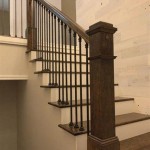How to Cover Cinder Block Walls: Interior DIY Ideas
Cinder block walls, while durable and affordable, can often lack visual appeal, appearing bare and industrial. However, with some creative DIY solutions, these walls can be transformed into attractive and stylish features within your home. This article explores several popular methods for covering cinder block walls, providing practical advice and inspiration for your next interior renovation project.
1. Paint: A Versatile and Affordable Option
Painting is perhaps the simplest and most budget-friendly way to cover cinder block walls. A fresh coat of paint can instantly brighten a room, create a cohesive look, and conceal the imperfections of the blocks. Consider the following tips for successful painting:
- Clean the Walls: Before painting, ensure the walls are clean and free from dust, dirt, and any loose debris. A damp cloth or a mild cleaning solution can be used for this purpose.
- Prime the Walls: Priming the walls before painting helps the paint adhere better and provides a smoother finish. A good quality primer designed for masonry surfaces is recommended.
- Choose the Right Paint: Opt for a paint specifically formulated for interior walls and masonry surfaces. Acrylic latex paint is a popular choice for its durability and ease of application.
- Consider Color and Finish: Experiment with different colors and finishes to achieve the desired aesthetic. For a modern look, consider a crisp white or a bold, contrasting hue. A matte finish can hide imperfections, while a semi-gloss finish adds a sheen and durability.
2. Wallpaper: Adding Texture and Pattern
Wallpaper offers a versatile option for covering cinder block walls, providing ample opportunity to introduce texture, pattern, and visual interest. Various wallpaper types, from traditional paper-based options to modern vinyl and peel-and-stick varieties, allow you to create a custom look for your space.
- Prepare the Walls: Before applying wallpaper, ensure the walls are smooth and free from bumps or irregularities. Spackle can be used to fill any imperfections, and a sanding block can be used to smooth out the surface.
- Choose the Right Wallpaper: Consider the type of wallpaper that best suits your needs and the style of your room. For a classic look, opt for traditional paper-based wallpaper. For durability and moisture resistance, vinyl wallpaper is a suitable choice. Peel-and-stick wallpaper offers ease of application and removal.
- Measure and Cut: Carefully measure the walls and cut the wallpaper panels to size, allowing for sufficient overlap.
- Apply Paste or Adhesive: Apply paste or adhesive to the back of the wallpaper panels, following the manufacturer's instructions. Carefully align and smooth the panels onto the walls, avoiding air bubbles or wrinkles.
- Trim and Finish: Once the wallpaper is applied, trim any excess using a sharp utility knife. Consider using a decorative molding to create a polished finish.
3. Tile: Durable and Stylish Coverage
Tile offers a durable and stylish solution for covering cinder block walls, particularly in areas prone to moisture or high traffic, such as kitchens, bathrooms, and basement spaces. Ceramic and porcelain tiles are popular choices for their durability, water resistance, and ease of maintenance.
- Prepare the Walls: Ensure the walls are clean, smooth, and free from any imperfections. Use a trowel to apply a thin layer of mortar or thinset to the wall surface, creating a smooth and even base for the tiles.
- Choose the Right Tile: Consider the size, shape, color, and style of tiles that best suit your aesthetic and functional needs. For high-traffic areas, consider durable and scratch-resistant tile options.
- Layout and Spacing: Plan the tile layout and spacing, using spacers to ensure consistent gaps between the tiles. This creates a visually pleasing pattern and allows for grout to be applied.
- Apply Tiles: Adhere the tiles to the mortar or thinset using a trowel, ensuring proper spacing and alignment. Press down firmly to ensure proper adhesion.
- Grout: Once the mortar or thinset has dried, apply grout to fill the gaps between the tiles. Use a grout float to spread the grout evenly and remove any excess.
By incorporating these DIY ideas, you can transform your cinder block walls into attractive and functional spaces within your home. With careful planning and execution, these simple techniques can elevate the aesthetic appeal of your interior, creating a welcoming and comfortable environment.

Stylish Solutions Covering Unfinished Basement Walls Csg Renovation

22 Fun And Ideas For Diy Cinder Block Projects

Stylish Solutions Covering Unfinished Basement Walls Csg Renovation

Stylish Solutions Covering Unfinished Basement Walls Csg Renovation

Rubbing Drywall Compound Onto A Cinder Block Wall Before You Paint Is An Easy That Will Fill All The Porous Holes Make Painting Lot Smoother
:strip_icc()/100160338-94183feb6e2b47c98f2d931608ce3352.jpg?strip=all)
18 Ways To Make Your Basement Walls Beautiful

3 Simple Methods How Are Concrete Block Interior Walls Finished

Stylish Solutions Covering Unfinished Basement Walls Csg Renovation

How To Easily Add Knockdown Texture Concrete Basement Walls
.jpg?strip=all)
Before After Painted Cinderblock Walls Dream Green Diy
Related Posts








